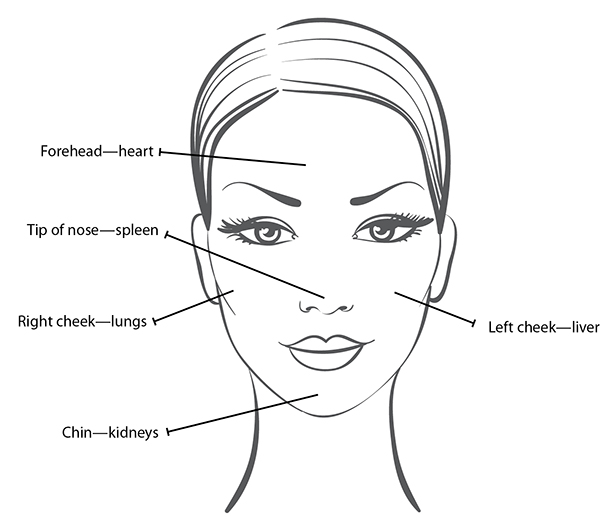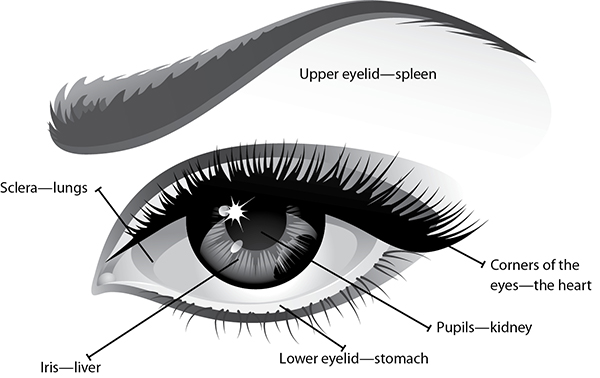Health is a state of complete harmony of the body, mind, and spirit. When one is free from physical disabilities and mental distractions, the gates of the soul open.
—B. K. S. Iyengar
CHAPTER 6
Diagnosis and Treatment with TCM
Before choosing the right herbs and foods for my patients, I first have to make a diagnosis and treatment plan. Chinese medicine has a unique way of diagnosing a patient. People who are new to acupuncture are amazed both by all the questions I ask and my examination: looking at the tongue, feeling the pulse for several minutes on both wrists, and palpating certain areas of the body. An initial intake can take up to an hour, depending on a patient’s overall condition and history. During an initial visit I ask quite a few questions about medical history, supplements and medications, lifestyle choices, eating and exercise habits, and much more. I check the texture and temperature of the client’s skin along certain energy channels; look at the complexion, hair quality, eyes, body type, and body language; and listen to the sound of the patient’s voice. I sometimes even smell the patient. If I sense that a patient is open or ready to be asked, I’ll ask about his or her emotional health and history as well. All of these help me in my diagnosis and to decide the best course of treatment for that particular individual.
Throughout this book, I’ll be using some potentially unfamiliar terms when discussing my patients’ symptoms. I want to make sure you have some background on how a diagnosis is made and how I decide on the best treatment for each of my patients. Do keep in mind that entire books have been written on each individual treatment method, so it would be impossible to summarize them all in only a few pages. Instead, I’ve taken some of the most vital information and simplified it. I am sharing some diagnostic tools with you here so you can see how exact TCM can be. Just remember that even if you see parallels with your own symptoms, please don’t use this chapter to self-diagnose or to start taking herbs without the help of a qualified practitioner. What makes Chinese medicine so different from Western medicine is that each patient is looked at as a whole system, not just as a symptom or two. Every person is unique, with a unique life experience and set of symptoms and ways of processing his or her emotions. So finding out as much as I can about my patients is important to giving them the best possible treatment, diet suggestions and results. We will start with what can easily be seen in a preliminary interview.
Face
You can tell a lot about the health of your organs and emotional health just by looking in the mirror. In TCM, it is believed that each organ and its correlating emotions manifest on a specific part of the face, so that a person’s complexion may reflect his or her state of mind. Have you ever paid attention to the face of a person who yells to himself or herself? Next time, take a look at their face (without staring!) and see what it is telling you.
- • The forehead represents the heart.
- • The tip of the nose is the spleen.
- • The chin is the kidneys.
- • The liver is the left cheek.
- • The lungs are reflected on the right cheek.

Facial acne is one of most obvious ways to help diagnose a patient. Patients who always get acne on their cheeks may have imbalances in either their liver or lungs. Usually acne, especially in adults, is an indicator that the liver is trying to flush out toxins through the skin. The solution? Eat some more of those dark, leafy greens and ginger I mentioned earlier for a mini detox.
Having digestive issues may result in a red-tipped nose, which indicates a weak spleen. Sally, the sugar addict mentioned in chapter 4, had a bright red nose.
Specific colors can also be an indicator that something is wrong with a particular organ. These colors can show up on the face, in the eyes, or on the skin anywhere on the body. A green hue to the complexion can mean there is a liver issue, such as cirrhosis. Redness usually means some form of internal heat, such as a fever, infection, or menopause. Yellow can be a sign of digestive issues, such as indigestion, diarrhea, or stomach flu. A very pale complexion can mean you are anemic. Anemia may be caused by either lack of or malabsorption of iron and/or vitamin B12.
Just like the skin of the face, the eyes can give you an idea of any imbalances in specific organs or their emotions. They’re not just the windows to the soul. The eyes can tell what’s going on internally.

Dark circles under the eyes can signify kidney imbalance, food allergies, possible caffeine poisoning (too much coffee) of the kidneys, and/or adrenal fatigue.
If the eyes are dull and/or clouded, it may be an indication of serious mental health issues such as bipolar disorder. Dullness can also sometimes be a side effect of certain medications.
If the corners of the eyes are red, you may be experiencing anxiety or insomnia.
I see a lot of people who have issues with sweat. They might think their sweating is normal, because they’ve “always been this way,” but it can be a sign that something is off balance internally. Like many symptoms, just because you’ve had the issue for years doesn’t mean it’s OK.
Sweating is a normal bodily function to regulate body temperature, but some types of sweating are abnormal. Anxiety especially affects how much you perspire, but any emotional imbalance can have an impact. You might sweat only on the head, which can mean, for example, heat in the stomach, stomach flu, or food poisoning, while sweat showing up solely on the forehead can mean a heart attack—and a need to see a doctor immediately. Sweat only on the arms and legs can mean a stomach or spleen deficiency and can be evidence of stress-induced digestion problems, eating disorders, or overuse of antibiotics. Sweat only on the hands can mean a lung qi deficiency or nerves, which can manifest as shortness of breath or frequent colds. If you sweat only during the day, it could mean a yang or qi deficiency, commonly seen in patients who always feel cold or tired. Sweat on the palms, soles of the feet, or chest can mean a yin deficiency, sometimes caused by menopause or cancer treatments. Finding emotional balance through increasing the right mood foods for you should stabilize your perspiration.
Headaches
Headaches are definitely a manifestation of imbalances. Unfortunately, they’ve become part of the norm. Common causes are eye strain from sitting in front of a computer too much and the overconsumption of caffeinated drinks, leading to dehydration. Depending on where on the head the pain is centered, or the quality of the pain itself, you can find out what organ(s) may need some TLC.
Headaches that occur only during the day may mean a qi or yang deficiency, which can manifest as fatigue or muscle weakness. By contrast, nighttime headaches can mean a blood or yin deficiency caused by anemia or the side effects of medications. Pain at the nape of the neck can mean a kidney deficiency, tight neck muscles, or the onset of a cold. Aching temples could mean liver or gallbladder imbalances, or a cold or flu. Pain at the vertex (top of the skull) is usually a sign of anemia. For example, my patient John with food poisoning had been complaining of a constant headache on the top of his head ever since getting sick. Because he was unable to keep anything down, he was dehydrated and anemic. Once he was able to eat and drink normally again, the headache disappeared. Pretty amazing, right? As I wrote earlier, these are just a few of many examples of the diagnostic tools used in TCM. But they should give you an idea of how many factors are taken into account when treating patients with this approach.
As you can now see, TCM isn’t really that weird. It makes perfect sense. The masters from thousands of years ago had it right. Treating the cause of illness using natural methods provides for a long, healthy, disease-free life.
